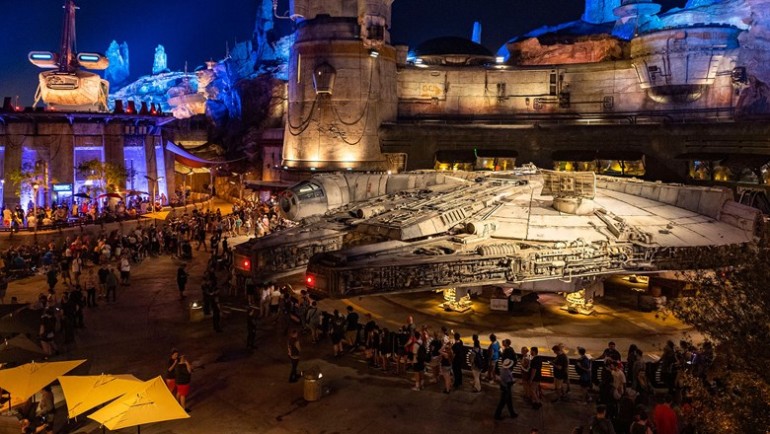Sponsored Listings:
When U.S. theme parks reopen, the guest experience will be decidedly different from the norm before they closed to help quell the spread of Covid-19.
While major parks such as Disney and Universal have not issued official guidance on policies and procedures for their attractions, mandatory face masks for employees and guests as well as temperature screening will be required in all likelihood. Park capacities will almost certainly be slashed and other measures will be put in place to decrease density and facilitate social distancing.
“I think there is going to be a lot of trial and error,” said Dennis Speigel, president and founder of theme park consultancy International Theme Park Services. “Some of these things will remain and some won’t work, and they’ll yank those. But you’re going to be instructed on what to do.”
Neither Disney nor Universal have announced reopening dates for their domestic theme parks. Disney did, however, open hotel reservations and theme park sales for Walt Disney World Resort in Orlando via its website, for reservations starting July 1. Both Disney and Universal have announced phased reopenings of their Orlando shopping and dining areas (May 20 and May 14, respectively). Face coverings will be required of guests and employees, and at Universal’s CityWalk, guests will undergo temperature checks.
Shanghai: An instructive opening
Disney also reopened Shanghai Disneyland on May 11, nearly four months after its Jan. 25 closure.
Speigel said the Shanghai opening could provide a road map for the reopening of U.S. parks. If they follow the same timeline, it would mean July openings (Walt Disney World closed March 16 and Disneyland Resort in Anaheim, Calif., closed March 14). He said the parks could open on a limited basis before then, testing procedures and public interest.
Edward Marks, founder and co-CEO of theme park consultancy the Producers Group, agreed that the opening of Shanghai could be instructive to the reopening of the U.S. parks, in that they would benefit from seeing which new policies and procedures prove to be successful in China. He said he believes U.S. parks could reopen by fall.
Disney did issue some guidelines about the Shanghai opening. Advanced reservations are required. The park is controlling capacity and practicing social distancing in queues, restaurants and on ride vehicles. Temperature screening is required, and guests must wear masks. Hand sanitizer is available at attraction entrances and exits, and additional sanitation is taking place in high-touch areas. Cast members have been trained in procedures such as contactless guest interactions.
On Disney’s recent earnings call, CEO Bob Chapek said the park was permitted to open with a capacity of 30%; typically, its daily capacity is about 80,000 visitors.
After the Shanghai opening was announced, Disney chief medical officer Dr. Pamela Hymel reiterated some of the plans the company is considering for all of its parks: phased reopenings, physical distancing and capacity measures, cleanliness and sanitation, screening and prevention support, and cast training.
A changed park landscape
Both Speigel and Marks speculated about what a visit to a theme park might be like in the immediate future.
First, Marks said, guests will likely go online to make reservations for their visit and pay for tickets. As Covid-19 testing becomes more readily available, guests might be required to provide proof that they are virus-free, he said.
Upon arrival, guests should expect temperature checks, Speigel said. Thermal-imaging cameras will also likely be employed around parks, as will cashless payments. Masks will be the new normal for guests and employees.
Capacity levels will definitely decrease. In its operational update on the Walt Disney World Resort website, the company confirmed theme parks, hotels, restaurants, attractions and experiences will be “limited in capacity and subject to limited availability or closure, based on direction from health experts and government officials to promote physical distancing.”
But while reduced crowd levels might make the period immediately following reopening seem like the best time to visit a theme park, measures in place inside the theme park will likely nullify that notion.
According to Marks, attraction queues (and likely other parts of the park) will be demarcated to enable social distancing.
Attraction vehicles will, at most, hold a capacity of 50% to ensure enough space is left between riders to adhere to social distancing guidelines, he predicted. Theaters, too, will be at a capacity of less than 50%, as every other row will be left empty and parties will be seated away from each other, leaving even more gaps.
Those measures will mean increased time to get on attractions or into shows. So, Marks said, if the park was operating at 50% total capacity, guests could expect similar levels of lines and waiting as they experienced pre-pandemic.
Outside of attractions, restaurants will likely see half their tables removed to encourage more distance between parties. Marks said 3D glasses will be given to guests upon entrance to the park to use for the day instead of at each attraction.
Cleanliness protocols will also become more visible, he predicted. While cleaning and disinfection will go on behind the scenes, it will also take place in full view to increase consumer confidence.
Source: travelweekly.com










